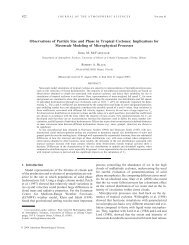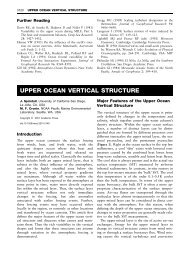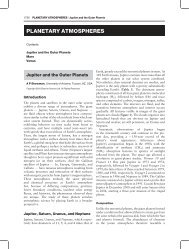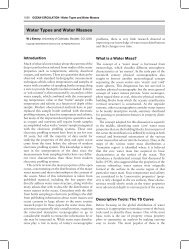Does the Sun contribute to Climate Change?
Does the Sun contribute to Climate Change?
Does the Sun contribute to Climate Change?
Create successful ePaper yourself
Turn your PDF publications into a flip-book with our unique Google optimized e-Paper software.
<strong>Does</strong> <strong>the</strong> <strong>Sun</strong> <strong>contribute</strong> <strong>to</strong> <strong>Climate</strong> <strong>Change</strong>?Pål BrekkeNorwegian Space CentrePål Brekketirsdag 1. november 111
His<strong>to</strong>rical sunspot recordsI 1610 pekte Galileo og Thomas Harriot teleskopet mot Solen forførste gang.Galileo skadet synet p.g.a. disse observasjonene.5tirsdag 1. november 11
The electromagnetic spectrumtirsdag 1. november 117
tirsdag 1. november 11
The dynamic <strong>Sun</strong>9tirsdag 1. november 11
Solar climate mechanisms• Long term variations in <strong>to</strong>tal solar irradiance (TSI)• Long term variations in UV/EUV irradiance - will lead <strong>to</strong> changes inchemistry (ozone), temperature and dynamics.• Long term variations in solar wind/magnetic fieldtirsdag 1. november 1111
Total Solar Irradiance (TSI)12tirsdag 1. november 11
There are two published TSI time series• PMOD shows little trend• ACRIM shows a more positive trendTotal Solar Irradiance (TSI)Scafetta, N., and R. C. Willson (2009), ACRIM-gap and TSI trend issue resolved using a surfacemagnetic flux TSI proxy model, Geophys. Res. Lett., 36, L05701, doi:10.1029/2008GL03630713Froelich el al 2008 (PMOD).tirsdag 1. november 11
Reconstructing solar irradianceDifferent methods and proxies are used (sunspot numbers, solar cycle length, Ca II images,o<strong>the</strong>r stars and geomagnetic indexes).TSI variation between 0.1 (0.0) - 0,6% since 1750 (0.2% often used in climate models)Solanki and Fligge 1998tirsdag 1. november 1114
Increase in Open Flux, IMF etc...EISCATVieira & Solanki A&A 509, A100, 2010tirsdag 1. november 1115http://www.mps.mpg.de/projects/sun-climate/resu_body.html
Reconstructed temperatures• The contribution from <strong>the</strong> <strong>Sun</strong> is very dependent on what TSIreconstruction one use.Scafetta, JASP (2009)tirsdag 1. november 11
Recent reconstructed TSI• Schrijver et al. (2011): finds an even smaller TSI variation thanIPCC• Shapiro et al. (2011): finds an increase up <strong>to</strong> 6 times more thanassumed by IPCCShapiro et al. Astronomy & Astrophysics 529, A67 (2011)tirsdag 1. november 11
Total Solar Spectral Irradiance (TSI)• The <strong>Sun</strong>s spectral irradiance back <strong>to</strong> 1700 (Fligge andSolanki, GRL, 2000)– TSI ! ! 0.2% !– UV
The solar EUV <strong>Sun</strong> - from min <strong>to</strong> max19tirsdag 1. november 11
Variations in <strong>the</strong> UV and climate change• The North Atlantic Oscillation isassumed <strong>to</strong> be affected by naturalvariations (e.g. solar activity).• NAO-index is important for <strong>the</strong>climate in Europe• NAO can be reconstructed back <strong>to</strong>1658 from pressure, temperatruesand percipitation.• <strong>Climate</strong> models suggest that lowsolar activity between 1400-1700altered <strong>the</strong> atmospheric circulation.• A “weaker” <strong>Sun</strong> reduced <strong>the</strong>westerly winds and cooled Europa.Shindell et al. Science, v294, 2149, 2001tirsdag 1. november 1120
Cosmic rays and climate - is <strong>the</strong>re a link?• GCR seeds low clouds (Svensmark + + +)• The GCR affects <strong>the</strong> electrical conductivity of <strong>the</strong> atmosphere through ionproduction (Tinsley +++)Eg. Ram, S<strong>to</strong>ltz and Tinsley, EOS, 90, 44, 2009tirsdag 1. november 1121
CGR - if <strong>the</strong>y affect cloudsMore active <strong>Sun</strong> than 100 years back:• Less CGR <strong>to</strong>day than before• Less low clouds than before• A warmer climate?tirsdag 1. november 1122
Cloud observations/modelling• Many studies support AND disputing solar GCR cloud correlations (e.g. Usoskin 2006; Svansmarket al. 2009; Sloan & Wolfendale 2008; Erlykin et al. 2009; Harrison 2008.......)• Some modelling studies support or dispute this mechanism (Yu et al. ACP 2008, KAzil et al.APC2006, Pierce & Adams GRL 2009.....).tirsdag 1. november 11
Are <strong>the</strong>re short term effects from GCR?• Svensmark et al. GRL, 36 (2009) studied <strong>the</strong> effects on low clouds and aerosols duringseveral strong Forbush events. Found that both water content and amount of lowclouds <strong>to</strong> vary (4%) ca 7 days after <strong>the</strong> reduction in GCR. The amount of aerosols alsochanged significantly (7%).• Kristjansson et al. 2008, Sloan & Wolfendale (2008), Kulmala et al. 2010, Calogovic el atGLR 37 (2010).... found weak or little effects,.,tirsdag 1. november 11
The CLOUD experimentNATURE paper + pressrelease: Confirms (SKY+ Aarhus experiments) that CR generates moreaerosols• However, particles <strong>to</strong> small (2 nm) <strong>to</strong> be able <strong>to</strong> generate condensation nucleus (50 nm limit)• MAYBE MORE IMPORTANT?: They found that climate models treat clouds in an improper way.Need <strong>to</strong> improve <strong>the</strong> models and how clouds are treated.• THE SAFE CARD: If <strong>the</strong> mechanisms should work - <strong>the</strong>re is no trend in <strong>the</strong> GCR data.tirsdag 1. november 1125
CLOUD eksperimentetHowever, in <strong>the</strong> online supplement (and in an earlierprodeeding paper from 2010) <strong>the</strong>re are resultsindicating that <strong>the</strong> particles grew <strong>to</strong> 70 nm.• There are trends in GCR datatirsdag 1. november 1126
Has <strong>the</strong> <strong>Sun</strong> changed <strong>the</strong> last 50 years?No trend in GCR, solar cycle length etc.. (e.g. Benestad 2005, GRL, 32, L15714)A systematic reduction in GCR of ca. 3.5% since 1964 (f.eks. Ahluwalia, 1997, JGR)A systematic reduction in GCR of ca. 15% <strong>the</strong> last 100 years (Lockwood, 2003, GRL)tirsdag 1. november 1127
GCR - climate effects• Siberian climate: Eichler et al GRL 36 (2009)• Ice rafted debris: Bond et al. Science 294 (2001)• Indian ocean monsoon: Neff et al. Nature 411(2001)• Asian monsoon: Wang et al. Nature 451 (2008)• Rainfall, droughts, river floods etc....28Kirkby 2009tirsdag 1. november 11
What´s up with <strong>the</strong> <strong>Sun</strong> <strong>the</strong>se days?• Total Solar Irradiance - lowest on record (1979)• UV irradiance 6% lower than <strong>the</strong> two previous minima• Solar cycle length > 13 year (longest since 1790)• Solar wind/magnetic field lowest in 50 years• GCR record hightirsdag 1. november 11
Status of <strong>the</strong> Earth´s temperatureHadCrut3 global temperature anomalyNo temperature increase after 2000CO2 emission increased with 25%www.climate4you.comtirsdag 1. november 11
Will <strong>the</strong> <strong>Sun</strong> “save us”?"A 0.1% decrease in <strong>the</strong> sun's irradiance has counteracted some of <strong>the</strong> warming action of greenhouse gases from2002 - 2008," says J. Lean. "This is <strong>the</strong> reason for <strong>the</strong> well-known 'flat' temperature trend of recent years." “Maywell slow down <strong>the</strong> temperature increase in <strong>the</strong> future”Questions that may be asked:•! Will <strong>the</strong> <strong>Sun</strong> “save us” from <strong>the</strong> consequencesfrom CO2 emission?tirsdag 1. november 1131Lean, J. L., and D. H. Rind (2009), How will Earth's surface temperaturechange in future decades?, Geophys. Res. Lett., 36, L15708
Dim <strong>Sun</strong> causes cold winters in Europa?Lockwood et al. 2010 Shindell et al. Science, v294, 2149, 2001tirsdag 1. november 11
Cold winters - natural variabilityThe average of recent winters (2008/9, 2009/10 and 2010/11) showscold conditions over nor<strong>the</strong>rn Europe and <strong>the</strong> United States and mildconditions over Canada and <strong>the</strong> Mediterranean associated withanomalously low and even record low values of <strong>the</strong> NAO.On decadal timescales <strong>the</strong> increase in <strong>the</strong> NAO from <strong>the</strong> 1960s <strong>to</strong>1990s…may also be partly explained by <strong>the</strong> upwards trend in solaractivity evident in <strong>the</strong> open solar-flux record….tirsdag 1. november 11
Different solar and anhtropogenic forcings may be restricted <strong>to</strong>certain areas!Forcing functions MAY NOT operate globally.<strong>Climate</strong> forcing functions MAY NOT operate immediately.Crozier, Anderson & Alexander, Science 8 august 2008Perry, Advances in Space Research, Vol 40, 2007tirsdag 1. november 11
What about our future <strong>Sun</strong>?Are <strong>Sun</strong>spots weakening?“<strong>Sun</strong>spots may vanish by 2015” - William Livings<strong>to</strong>n andMat<strong>the</strong>w Penn, National Solar Observa<strong>to</strong>ry at Kitt PeakEos, Vol. 90, No. 30, 28 July 2009 +tirsdag 1. november 11
What is happening with <strong>the</strong> <strong>Sun</strong>?A missing jet stream, fading spots, and slower activity near <strong>the</strong> poles saythat our <strong>Sun</strong> is heading for a rest periodLatitude-time plots of jet streams under <strong>the</strong><strong>Sun</strong>'s surface show <strong>the</strong> surprising shutdown of<strong>the</strong> solar cycle mechanism. New jet streamsassociated with a future 2018-2020 solarmaximum were expected <strong>to</strong> form by 2008 butare not present even now, indicating a delayedor missing Cycle 25.“Large-Scale Zonal Flows During <strong>the</strong> Solar Minimum -- Where Is Cycle25?” by Frank Hill, R. Howe, R. Komm, J. Christensen-Dalsgaard, T.P. Larson,J. Schou & M. J. Thompson.“Whi<strong>the</strong>r Goes Cycle 24? A View from <strong>the</strong> Fe XIV Corona” by R. C. Altrock.“A Decade of Diminishing <strong>Sun</strong>spot Vigor” by W. C. Livings<strong>to</strong>n, M. Penn& L. Svalgard.tirsdag 1. november 1136
What will <strong>the</strong> <strong>Sun</strong> do in <strong>the</strong> future?Dal<strong>to</strong>nMinimumE.g. H. Abdussama<strong>to</strong>v (2009), Lockwood et al. (2009)tirsdag 1. november 11
Natural climate cyclesPacific DecadalOscillations (PDO),Atlantic MultidecadalOscillaition(AMO) andSou<strong>the</strong>rn OscillationIndex (SOI)Ole Humlumtirsdag 1. november 11
Natural climate cyclesOle Humlumtirsdag 1. november 11
Natural climate cyclesOle Humlumtirsdag 1. november 11
SummaryNei<strong>the</strong>r anthropogenic or natural variations can alone explain <strong>the</strong>temperature variations <strong>the</strong> last 150 years.It is not only CO2 and/or <strong>the</strong> <strong>Sun</strong>Whatever mechanisms caused past climate change may work <strong>to</strong>dayand will most probably also work in <strong>the</strong> future.Don’t always expect <strong>to</strong> find a perfect fit <strong>to</strong> solar proxies and globaltemperature trends.Solar activity at a record high last 50 years - can this continue <strong>to</strong>«pump» energy in<strong>to</strong> <strong>the</strong> climate system?The only thing we know for sure is that <strong>the</strong> <strong>Sun</strong> will NOTbe constant <strong>the</strong> next 100 years.tirsdag 1. november 1140
tirsdag 1. november 11Hard-cover, E-book, Kindle and Ipad version in Nov/Dec 2011








![Chapt 2.5 [PDF]](https://img.yumpu.com/24218624/1/190x146/chapt-25-pdf.jpg?quality=85)